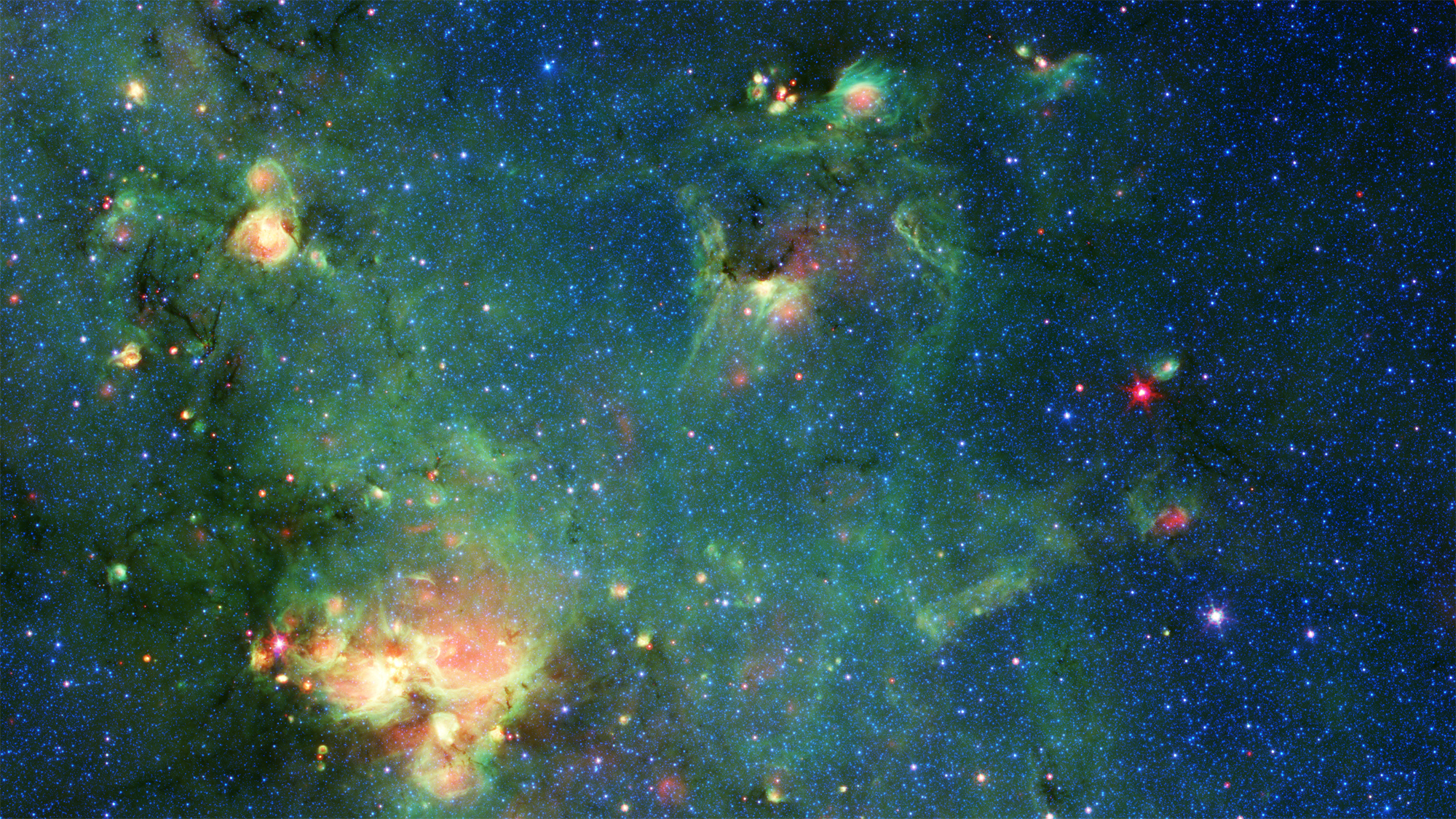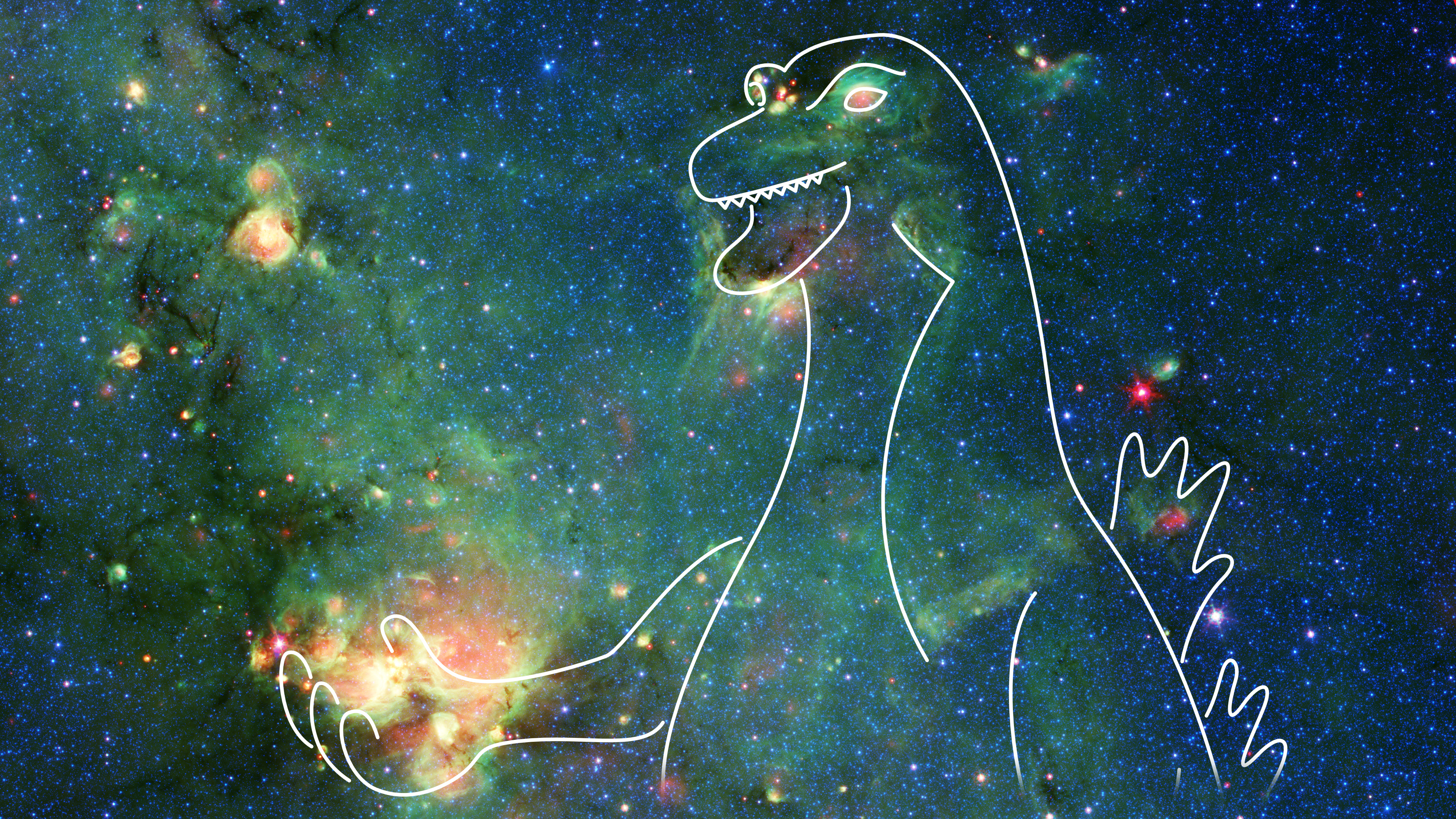'Godzilla' monster spotted in colorful nebula by zombie space telescope
Spitzer ended its mission in 2020, but is still generating data from its 16 years of observations.

A dead space telescope's data reveals a gas cloud that looks like the iconic sci-fi monster Godzilla.
If you look carefully at a new infrared image from NASA's Spitzer Space Telescope, you can spot monster features such as glowing eyes, a roaring mouth and even a dramatic hand or paw glowing in the dark.
While the shape is a cosmic coincidence, what the new image shows is the value of continuing to use telescopic data even after a mission has completed. In this case, we're looking here at imagery collected by the NASA Spitzer Space Telescope nearly two years after it ceased operations in January 2000.
While you can argue it was a zombie telescope that observed this so-called monster in space, the individual who processed the image didn't see it that way. "I wasn’t looking for monsters," Robert Hurt, a California Institute of Technology astronomer, in a statement from NASA's Jet Propulsion Laboratory.
Related: These Scary Things in Space Will Haunt Your Dreams

"I just happened to glance at a region of sky that I’ve browsed many times before, but I’d never zoomed in on," added Hurt, who has created most public images from Spitzer data since its 2003 launch. "Sometimes if you just crop an area differently, it brings out something that you didn’t see before. It was the eyes and mouth that roared 'Godzilla' to me."
Hurt and other humans who look at cosmic images can be prone to a tendency called pareidolia, which is a scientific name for humans to see shapes such as faces in otherwise random data. One of the more famous historic examples was the so-called Face on Mars, from Viking 1 orbital data in 1976. Viking happened to be flying overhead at a time when the shadows just aligned on a rock feature, appearing as a face.
Get the Space.com Newsletter
Breaking space news, the latest updates on rocket launches, skywatching events and more!
Playfully, JPL pointed to other examples of pareidolia that astronomers saw in Spitzer data, including a black widow spider, a Jack-o-Lantern, a snake, an exposed human brain, and even the Starship Enterprise from "Star Trek."
Gallery: Strange Nebula Shapes, What Do You See?
"It's one of the ways that we want people to connect with the incredible work that Spitzer did," Hurt said of this fantasy approach to otherwise serious science. "I look for compelling areas that can really tell a story. Sometimes it’s a story about how stars and planets form, and sometimes it’s about a giant monster rampaging through Tokyo."
The real-life region represented by Godzilla in this image is complex, first captured during Spitzer's work under a program called GLIMPSE (Galactic Legacy Infrared Mid-Plane Survey Extraordinaire). GLIMPSE surveyed the Milky Way galaxy's plane in four infrared wavelengths and generated 440,000 images, including this one.
"Stars in the upper right, where this cosmic Godzilla’s eyes and snout would be, are an unknown distance from Earth — but within our galaxy," JPL stated. "Located about 7,800 light-years from Earth, the bright region in the lower left — Godzilla’s right hand — is known as W33."
The material here is rich in star-forming stuff, and as young stars came into being their radiation blew away the dust and gas in the region, JPL noted. Changes can also happen when massive older stars explode as supernovas, which sprinkles the nearby area with heavy elements that can coalesce into planets or other objects.
Spitzer's infrared eyes allowed scientists to learn more about this region, which is otherwise filled with dust and thus invisible to human eyes. Four colors (blue, cyan, green and red) represent the four infrared wavelengths Spitzer used, while yellow and white are combinations of the wavelengths, JPL said. (If you're looking for the dust, that's in green and red, with red being the dust heated by stars or supernovas.
If you want to create your own creatures using Spitzer data, the California Institute of Technology's Spitzer Artistronomy web app allows you to do so for free.
Follow Elizabeth Howell @howellspace, or Space.com @Spacedotcom. We're also on Facebook and Google+. Original article on Space.com.
Join our Space Forums to keep talking space on the latest missions, night sky and more! And if you have a news tip, correction or comment, let us know at: community@space.com.

Elizabeth Howell (she/her), Ph.D., was a staff writer in the spaceflight channel between 2022 and 2024 specializing in Canadian space news. She was contributing writer for Space.com for 10 years from 2012 to 2024. Elizabeth's reporting includes multiple exclusives with the White House, leading world coverage about a lost-and-found space tomato on the International Space Station, witnessing five human spaceflight launches on two continents, flying parabolic, working inside a spacesuit, and participating in a simulated Mars mission. Her latest book, "Why Am I Taller?" (ECW Press, 2022) is co-written with astronaut Dave Williams.
